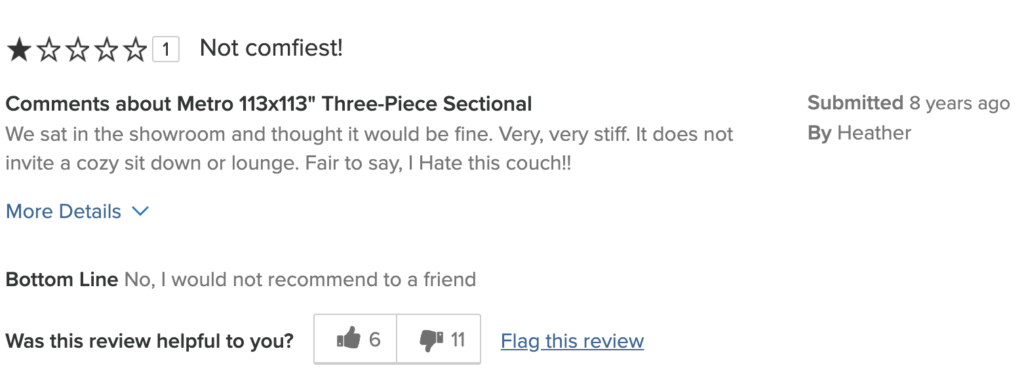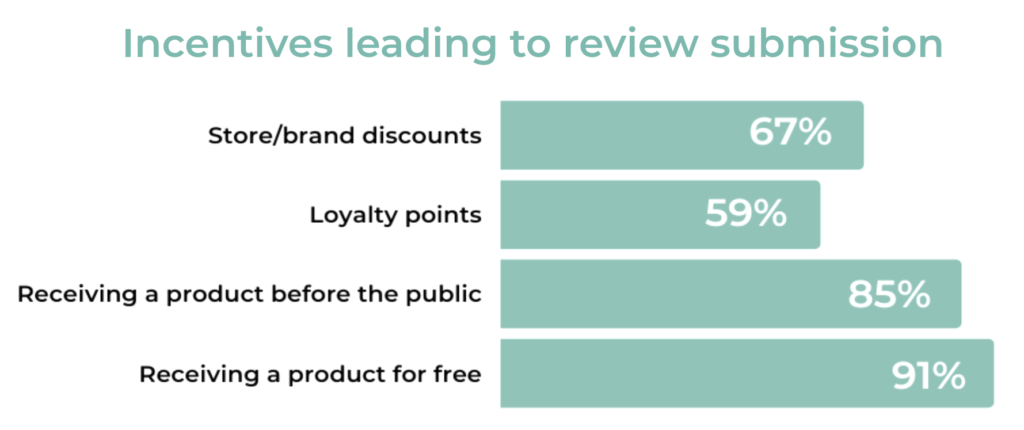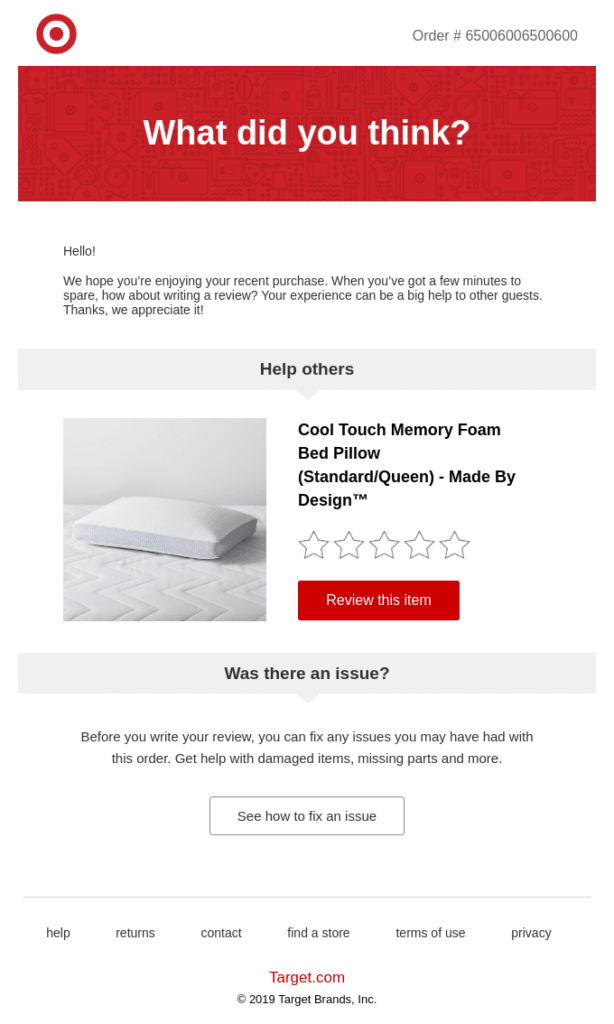Regardless of what they’re shopping for, modern consumers depend on reviews to make informed decisions. Our most recent survey found that 99.9% of online shoppers read reviews, and 57% of in-store shoppers do so.
Brands and retailers that generate and display plenty of this content experience a healthy boost to the bottom line. At PowerReviews, we’ve found that when a product page goes from having no reviews to one review, there’s a 108% increase in organic traffic — which means more eyes on your product pages. And our recent analysis of activity on 1.5MM online product pages from more than 1,200 brand and retailer sites found that there’s a 120.3% lift in conversion when a visitor interacts with ratings and reviews on a product page!
With results like these, it’s no wonder why many brands and retailers make it a priority to collect more reviews. In fact, one of the most common questions we get from our customers is, “How can we generate more reviews?”
Of course, there are a number of tactics commonly used to generate reviews, including post purchase emails and SMS messages, among others. But in order to boost your number of reviews, it’s essential to understand why consumers choose to write reviews in the first place.
We recently surveyed more than 10,000 U.S. shoppers specifically to understand the factors that motivate shoppers to write reviews. Here’s a snapshot of the results:

In this post, we’ll zero in further to explore the top five reasons shoppers write reviews — and how your brand can leverage these motivations to start generating a higher volume of this conversion-boosting content.
Motivation #1: A Positive Experience
The most successful businesses are those that are laser-focused on consistently delivering great products and experiences. In fact, a study from Forrester Consulting on behalf of Adobe found that 80% of businesses say that improving customer experiences is a top priority.
Efforts to improve customer experience, when done right, pay off. Great products and experiences lead to happy customers who are likely to spend more with your brand — and tell others about their positive experiences. Research from American Express found that Americans tell an average of 11 people about a great experience with a brand.
What’s more, great experiences motivate shoppers to leave reviews. 91% of those we surveyed indicate that a positive experience is a factor that motivates them to submit a review.
These positive reviews give future shoppers the confidence they need to convert. So make it a priority to deliver great experiences to shoppers across all stages of the customer journey. Of course, offering great products is important. But so too is ensuring each experience a shopper has with you — whether it’s browsing on your website or mobile app, shopping in one of your stores, or interacting with a customer service representative to resolve an issue — is a positive one.
Motivation #2: Receiving Free Product Samples
Product sampling is a tactic that’s been used by consumer packaged goods (CPG) companies for years. And for good reason. People are more willing to take the risk of trying a new (or new to them) product if they don’t have to pay for it. And the hope is that those consumers will love the product so much, they’ll start buying it.
In our latest survey, we also found that 86% of consumers said that free samples motivate them to write reviews. This aligns with the fact that at PowerReviews, we find that an average of 86% of consumers who receive a sample as part of a sampling campaign go on to write a review.
Sampling campaigns not only yield a high volume of content quickly, they also yield great quality content. At PowerReviews, we find that reviews from sampling campaigns are 83% longer on average than reviews captured via non-sampling tactics. This is good news, as detailed reviews are typically more helpful than short, vague ones.
So if you’re releasing new products (or just have products in need of additional reviews), consider a product sampling campaign. This involves sending out free samples to current customers (or an engaged community of consumers), and then asking for reviews in return.
When it comes time to display these reviews, remember that transparency is key. Add a badge to these reviews to make it clear that they were submitted as a part of a sampling campaign.

Motivation #3: A Negative Experience
The same American Express research we cited earlier found that on average, Americans tell 15 people about bad experiences they have with a brand. These unhappy customers aren’t just telling their friends and family though. They’re also sharing their feedback with complete strangers by writing reviews. In fact, a negative experience motivates 76% of shoppers to leave a review.
Of course, we’d never encourage you to purposely deliver negative experiences and subpar products in order to generate more reviews. After all, a customer who has a bad experience probably isn’t going to leave a very flattering review. And negative reviews should never be something to aim for!
But the reality is, the occasional negative review isn’t the end of the world. In fact, it can actually be a good thing.
For starters, our latest survey found that 96% of consumers specifically look for negative reviews, up from 85% in 2018. Reading negative reviews helps shoppers understand the worst case scenario — and decide whether it’s something they can live with. For example, a consumer shopping for a couch might see this one-star review for one product, mentioning that it’s “very, very stiff.” But she prefers firm couches, so this isn’t a concern to her.

A perfect average star rating can also be a red flag for shoppers because they know a product can’t be all things to all people. Nearly half of shoppers indicate they’re suspicious of products with an average star rating of five out of five. So by displaying negative reviews alongside positive ones, you’re showing shoppers that you have nothing to hide — and that you’re a brand they can trust.
Finally, negative reviews can be a great way to identify ways to improve your products and experiences. For example, if an athletic apparel brand notices that a particular shirt has a lot of negative reviews that mention the product falling apart soon after purchase, there may be an opportunity to work with the manufacturer to improve the quality of the item.

The bottom line? Don’t aim for negative reviews. But when you get a negative review, resist the temptation to delete it. And be sure to respond to it. According to Salesforce’s State of the Connected Customer, 78% of shoppers will forgive a company for a mistake after receiving excellent service. Your response will also show future shoppers that you value feedback and stand behind your products.
If you want to find out more about how to use negative reviews to your benefit, check out our blog on this very topic.
Motivation #4: Incentives
There are plenty of customers who submit reviews without receiving anything in return. However, nearly three-quarters (73%) of consumers we surveyed said that an incentive would entice them to write a review.
A small incentive can go a long way. So consider offering one to shoppers in exchange for a review. Of course, it’s important to choose an incentive that’ll work well for your brand. However, some options that are particularly appealing to consumers include:
- Discounts
- Loyalty points
- Receiving a product before it’s sold to the general public
- Receiving the product free of charge

Be sure to make the offer clear in your post purchase emails. For example, this post purchase email is offering an entry into a sweepstakes for a $200 gift card in exchange for a review.
Again, transparency is key. Be sure to make it clear when a review was submitted as the result of an incentive. For example, this review includes a “sweepstakes entry” badge, which indicates the customer received an entry into a sweepstakes in exchange for submitting her review.
Motivation #5: Helping and Guiding Others
Sure, free samples and incentives can boost review submission rates. But there are plenty of consumers — 67% in fact — who say that the opportunity to help and guide other shoppers is a great motivator to write a review.
Consider tweaking the language in your post purchase emails and write-a-review form to position reviews as a great way to help fellow shoppers. For example, this post purchase email highlights that the customer’s feedback is a “big help to other guests.”

Leverage Top Shopper Motivations to Start Generating More Reviews
Today’s shoppers depend on reviews to make informed purchase decisions. And generating a steady stream of this content can enable you to get more visitors to your product pages — and convert them once they’re there.
Now’s the time to hone your review generation strategy. Once you understand why shoppers write reviews in the first place, you can then focus your efforts on tapping into these motivators to start generating a higher volume of reviews.


